Astronomical Events Information | 2016 | March
March 9, 2016, Partial Eclipse Visible Throughout Japan
Let’s Safely Observe the Solar Eclipse!
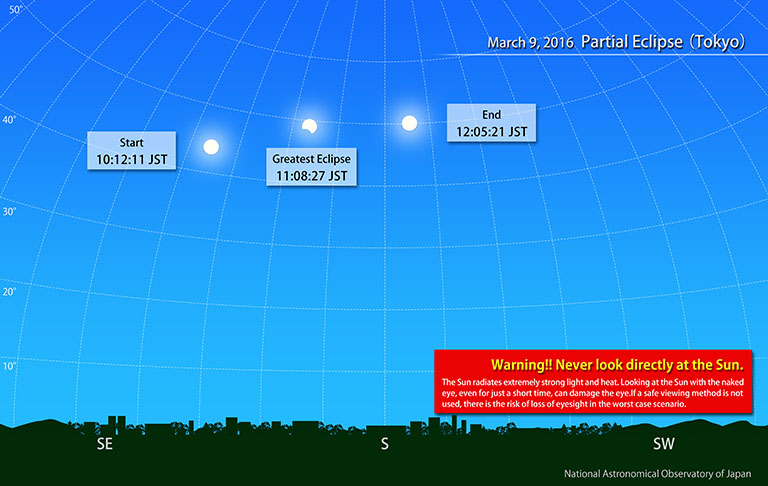
A total solar eclipse occurs on March 9, 2016.
The total solar eclipse is visible from the area around Indonesia. From Japan, it can be observed as a partial eclipse.
The Sun radiates extremely strong light and heat. Please observe it using a safe method, such as by employing specialized equipment.
What is a Solar Eclipse?
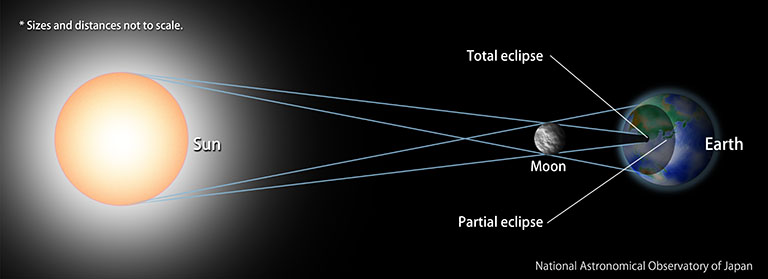
A solar eclipse is a phenomena where part (or all) of the Sun is concealed because the Moon crosses in front of it.Solar eclipses are divided into the following 3 categories, based on how the Sun is concealed.
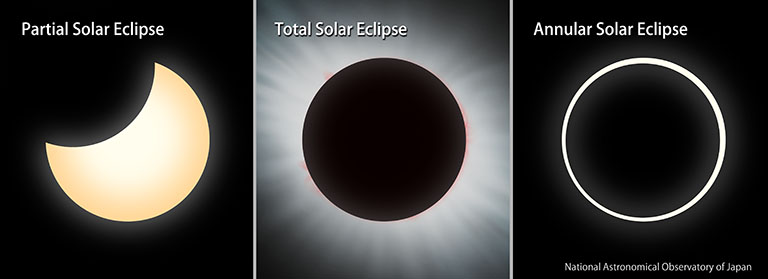
- Partial Solar Eclipse
- Only a portion of the Sun is concealed by the Moon
- Total Solar Eclipse
- All of the Sun is concealed by the Moon
- Annular Solar Eclipse
- Because the Moon appears smaller than the Sun at this time, the Sun can be seen spilling out around the edges of the Moon.
About this Solar Eclipse
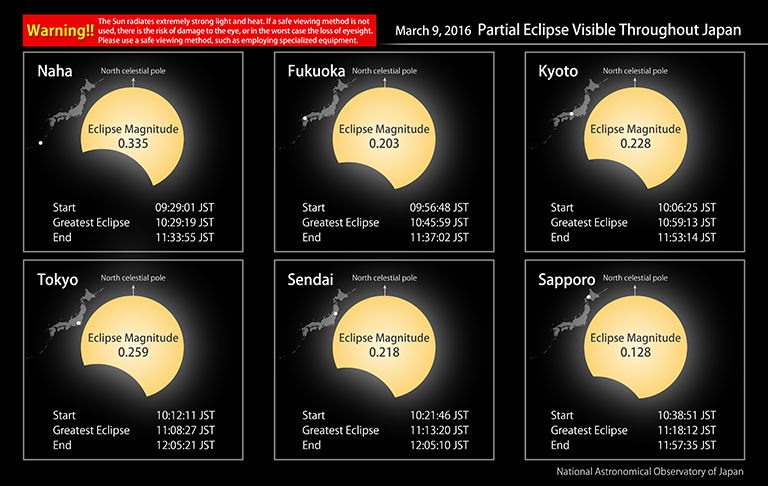
This solar eclipse appears as a total solar eclipse for the area around Indonesia. For Japan, it is a partial eclipse. The Moon will cover 22 percent of the solar disk as seen from Naha; 15 percent of the solar disk as seen from Tokyo; and 5 percent of the solar disk as seen from Sapporo.
The eclipse information for major locations in Japan is listed below.
| Location | Start | Greatest Eclipse | Eclipse Magnitude(*1) | Area Ratio(*2) | End |
|---|---|---|---|---|---|
| Naha | 09:29:01 | 10:29:19 | 0.335 | 0.223 | 11:33:55 |
| Fukuoka | 09:56:48 | 10:45:59 | 0.203 | 0.107 | 11:37:02 |
| Kyoto | 10:06:25 | 10:59:13 | 0.228 | 0.128 | 11:53:14 |
| Tokyo | 10:12:11 | 11:08:27 | 0.259 | 0.154 | 12:05:21 |
| Sendai | 10:21:46 | 11:13:20 | 0.218 | 0.119 | 12:05:10 |
| Sapporo | 10:38:51 | 11:18:12 | 0.128 | 0.054 | 11:57:35 |
*1 Eclipse Magnitude: the fraction of the Sun’s diameter covered by the Moon.
*2 Area Ratio: the fraction of the solar disk’s area concealed by the Moon.
Reference: Local Prediction of the Solar Eclipse (NAOJ Ephemeris Computation Office)
To find forecasts for regions not listed above, please refer to the NAOJ Ephemeris Computation Office’s “Local Prediction of the Solar Eclipse” webpage.
Solar Eclipse Viewing Methods
The Sun is unbelievably bright; 460,000 times brighter than the full moon. If you look directly at the Sun with the naked eye, even for just a short time, it will hurt your eyes.
Even when the Moon covers a portion of the Sun, it doesn’t change the fact that the Sun’s light and heat are still very strong. Unless you use safe techniques to observe the eclipse, in the worst case scenario, there is the danger of losing your eyesight.
Thing Which Don’t Work
Things such as the following will hurt your eyes and should not be attempted.
Even if the sunlight doesn’t feel dazzling bright, there is the danger of damaging your retina if there is insufficient light attenuation or if you are using something which allows wavelengths of light harmful to the eye to pass through.(This photograph was taken without actually looking at the Sun.)

Looking directly at the Sun
with the naked eye
Use of a telescope
or binoculars (*1)
Use of a colored plastic
sheet or CD (*2)
Use of film scraps (*3) 
Use of soot-blackened glass 
Use of sunglasses or goggles 
Use of an eclipse viewer to
look though a telescope or
binoculars
*1: Because telescopes and binoculars collect and concentrate the light and heat from the Sun, this is more dangerous that viewing the eclipse with the naked eye. But telescopes and binoculars with appropriate light attenuation prepared by experts can be used for solar eclipse viewing.
*2: There are tinted plastic sheets approved for solar viewing which are commercially available.
*3: Negatives prepared by an expert by adequately exposing and developing silver-bearing black-and-white film can be used for solar eclipse viewing.
Safe Observation Methods
1. Using a Pinhole
The light from the Sun will trace out the shape of the dwindling Sun when it passes through something which throws a shadow with small gaps, such as a piece of cardboard or similar material with a small hole punched in it, a woven straw hat, or the sunlight filtering through foliage. This works on the same principle as a pinhole camera. Because this does not involve looking directly at the Sun, it is a safe method to observe a solar eclipse.
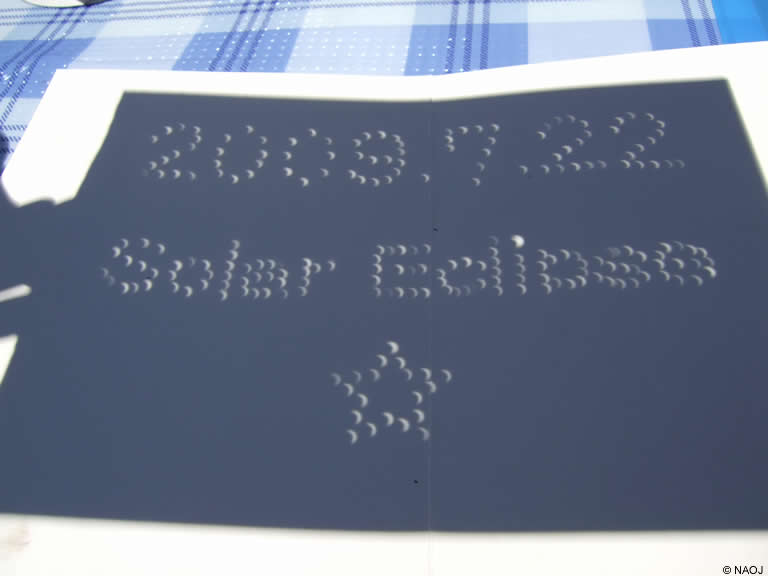
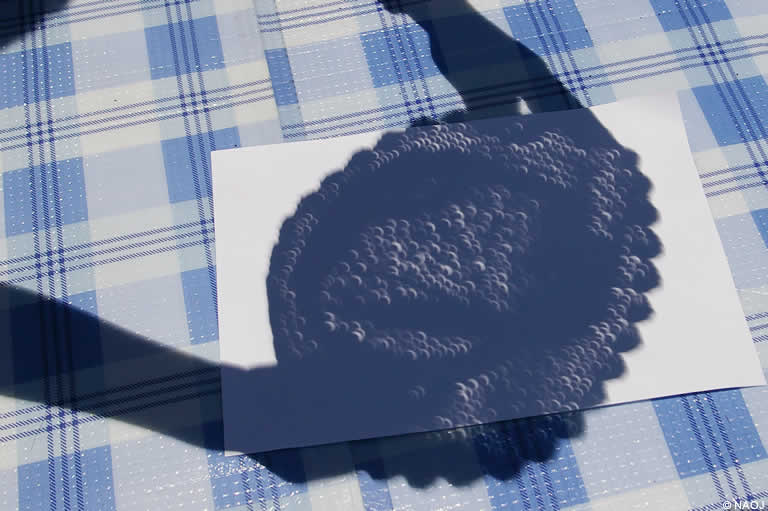
2. Using a Solar Eclipse Viewer
When used correctly, specialized solar eclipse glasses or a shielding plate (collectively known as ‘eclipse viewers’) allow a solar eclipse to be viewed safely. (Normal sunglasses etc., no matter how thick, still transmit the Sun’s strong light and heat.) Make sure to read the safety instructions to confirm the proper usage. In addition, please observe the following rules.
- Please hold the eclipse viewer close to your face to prevent the Sun’s light from entering your eye around the edges.
- Make sure not to remove the eclipse viewer from your eyes while your face is turned towards the Sun.
- Even when using an eclipse viewer, please keep the time spent observing the Sun short; don’t stare for extended periods.
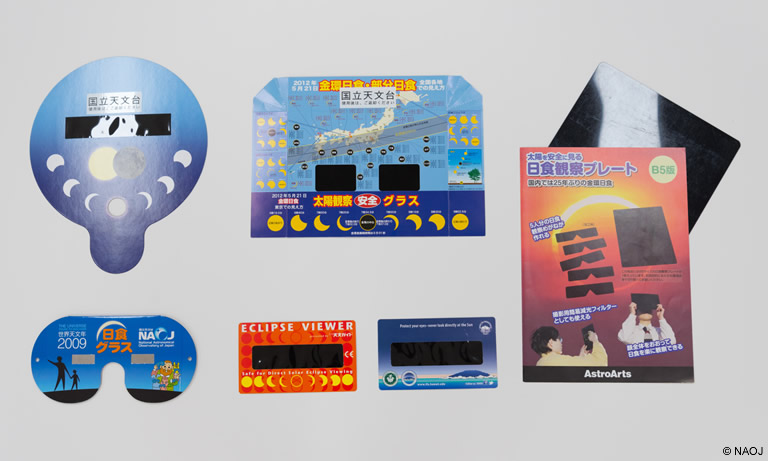
3. Using a Telescope to Project the Sun onto a Projection Board
By projecting an image of the Sun onto a solar projection board attached to a telescope, many people can watch the progression of the solar eclipse at the same time.
Some telescopes are unsuited for solar projection observations. Please refer to the instruction manual of each telescope.
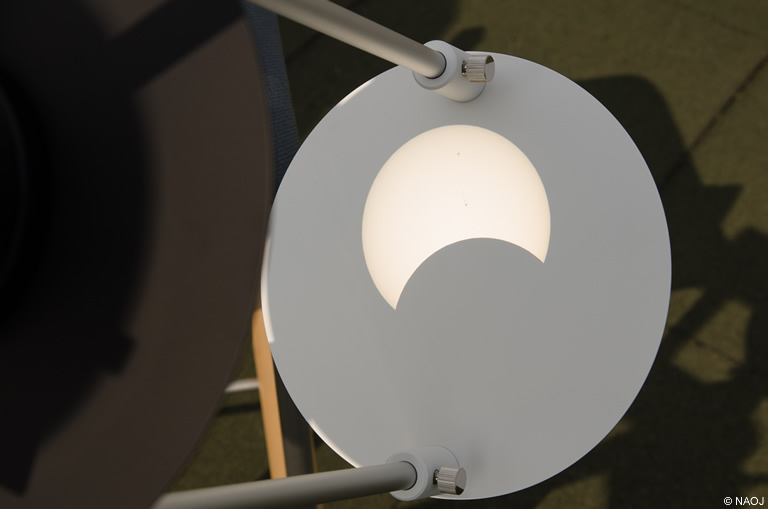
The list of save viewing methods presented on this page is not comprehensive.
Also, in some cases it is possible to safely observe a solar eclipse using some of the observation methods which this page labels as “Things Which Don’t Work” by combining them with appropriate light attenuation or by carefully selecting the materials to be used. However, using ad hoc methods without expert knowledge carries the risk of damage to the eyes or loss of sight in the worst case. Rather than using your own untested methods, please ask for guidance from a specialist.